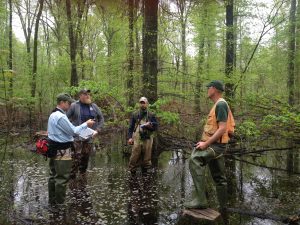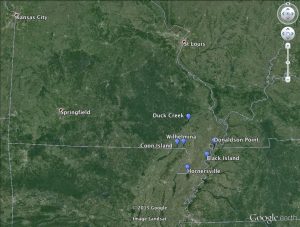 When biologists or conservationists think about the most imperiled habitats in Missouri, prairies and marshes usually come to mind. We have lost more than 99% of our native prairies and about 85% of our native wetlands. However, there is another habitat type that is also undergone enormous losses, and that is the bottomland hardwood forest community. After the majority of our river floodplains were logged in the 1800’s and early 1900’s, the remaining land was found to contain extremely rich, fertile soil – perfect for farming. Today, less than 20% of the original 4 million acres of bottomland hardwood forest remains in Missouri (for a great read on this ecosystem see the article “Lowland Treasures” in the Missouri Conservationist).
When biologists or conservationists think about the most imperiled habitats in Missouri, prairies and marshes usually come to mind. We have lost more than 99% of our native prairies and about 85% of our native wetlands. However, there is another habitat type that is also undergone enormous losses, and that is the bottomland hardwood forest community. After the majority of our river floodplains were logged in the 1800’s and early 1900’s, the remaining land was found to contain extremely rich, fertile soil – perfect for farming. Today, less than 20% of the original 4 million acres of bottomland hardwood forest remains in Missouri (for a great read on this ecosystem see the article “Lowland Treasures” in the Missouri Conservationist).
The Missouri Department of Conservation has been working hard to conserve and restore what is left. MDC Foresters have made great strides in improving forest management in Missouri’s riverine areas. They are now implementing many complex practices to restore natural hydrology, tree species composition, and ecosystem function to bottomlands throughout the state. Progressive forestry practices in the Bootheel, based on Lower Mississippi Valley Joint Venture (LMVJV) guidelines and the many years of experience of local MDC Foresters, have been put in place to dramatically improve the health of our public bottomlands.
The MDC’s Natural Areas Coordinator Mike Leahy approached MRBO with a proposal for bird surveys in the forests of the Bootheel. We very much welcomed this idea due to the conservation value of bottomland forests and the opportunity for MRBO to contribute to habitat conservation in a new way. Since MDC forest practices in the Bootheel have incorporated LMVJV’s management guidelines, MRBO and the MDC wanted to also use the its bird survey protocol. By doing so, we are able to follow well-tested data analysis procedures and can also contribute Missouri’s data to the regional forest conservation effort.
 The protocol used on the bottomlands project is quite different than other MRBO survey projects. We usually employ transect surveys as opposed to point counts; transects work very well in open country and a great deal of ground can be covered while detecting birds. Therefore, this method is great for grassland and wetland surveys. While transects can be used in a few types of forest (for example, mature upland pine forest with little to no understory), in the bottomlands point counts are definitely the method of choice. This is why the LMVJV bird survey protocol involves a strictly timed point count session conducted at randomly selected points within each forest unit. For 2015 surveys, six forested CAs (below right) were selected that each contained recently managed units and “control” units consisting of mature forest that had not undergone any recent management actions.
The protocol used on the bottomlands project is quite different than other MRBO survey projects. We usually employ transect surveys as opposed to point counts; transects work very well in open country and a great deal of ground can be covered while detecting birds. Therefore, this method is great for grassland and wetland surveys. While transects can be used in a few types of forest (for example, mature upland pine forest with little to no understory), in the bottomlands point counts are definitely the method of choice. This is why the LMVJV bird survey protocol involves a strictly timed point count session conducted at randomly selected points within each forest unit. For 2015 surveys, six forested CAs (below right) were selected that each contained recently managed units and “control” units consisting of mature forest that had not undergone any recent management actions.
While every bird seen and heard on survey is recorded, the LMVJV has identified a set of priority species that are of highest conservation concern. Of this list of 16 species, MRBO point counts documented 12 during 2015-17 surveys (n=988), many of them in large numbers. Acadian Flycatcher and Prothonotary Warbler alone comprised 279 individual bird detections. A big highlight was several Swainson’s Warblers recorded at Donaldson Point CA. Numbers of Swainson’s Warbler have diminished throughout the species’ range because it is reliant on extensive cane thickets for nesting. While cane has grown quite scarce throughout the southeast as a result of logging, the Bootheel forests still have several cane thickets. As Forester Mark Pelton said, “right now we have a lot more available cane than we do Swainson’s Warblers!” As Mark and his colleague Ross Glenn continue to improve forest conditions, we expect to see associated increases in the Swainson’s Warbler population as well as other species of conservation concern.
See MRBO’s report for 2015-2017 bottomland forest breeding bird surveys.